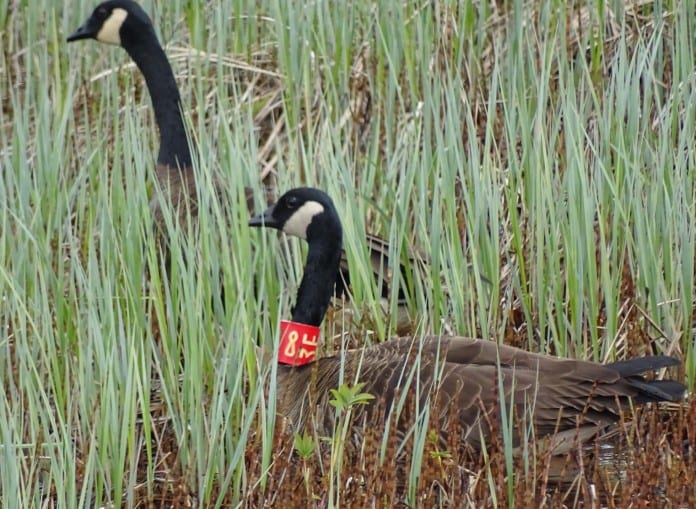Spring is a wonderful season, especially after a long Alaskan winter. Snow melts in the powerful sun, greenery emerges, all of the birds start returning and fishing season is just around the corner! One of the most iconic signs of spring returning is that undistinguishable honk of overhead geese.
Lifelong Cordovans are more than likely aware of the dusky Canada goose and their presence on the Copper River Delta. The Copper River Delta is the primary breeding grounds for this subspecies of Canada goose whose population has fluctuated over the years. Maybe you have noticed something red around their necks and wondered what they are for?
Biologists and bird researchers have different ways of marking birds. This includes metal leg bands, which usually always accompany other markers, to color coded bands on shorebirds legs, to wing tags on eagles and neck collars on dusky Canada geese. The idea of marking birds is to gain valuable information on that bird’s life history. Once a bird is marked that bird needs to be documented again via capturing at a later date, re-sighting markers from a distance (i.e. reading neck collar codes on geese or getting pictures of a shorebird with color marked leg bands), or found dead. Waterfowl have the highest band-reporting rate of all birds banded because they are actively hunted across all flyways. Once a hunter harvests a banded bird (or when a citizen re-sights an individual bird with a marker), they report that encounter to the Bird Banding Lab who is maintained by the US Geological Service in Patuxent, MD. This data provides tons of good information like specific migration timing and patterns, specific harvest rates for hunted species, estimates of survival rates between juvenile and adults as well as more detailed population ecology parameters.
The dusky Canada goose is a species of concern for managers in the Pacific Flyway. We have the unique ability in Cordova to interact with this species on their breeding ground. Every other year the Cordova Ranger District and Forest Service staff help the Alaska Department of Fish and Game’s waterfowl biologists band and collar duskies on the Delta. Alaska is currently the only place where duskies are allowed to be harvested in the US and even then, the state postpones goose season for Canada geese until the end of September to allow the dusky population to start their southbound migration. Without harvest on the wintering grounds (WA and OR), which would provide band return data, biologists in the Pacific NW rely on neck collar re-sighting efforts to calculate population and survival estimates.
So what can you do to help?
When you see a red neck collar on a goose, stop and try to read the 3 digit code. Dusky collars are red with white codes, 3 digits with the 1st digit reading horizontal and 2nd/3rd digits reading vertical from the bottom up. The code is marked on the front and back of the neck collar. You may have to watch the goose for a while to get all 3 digits. A good zoom on a camera or digiscoping your phone camera through a pair of binoculars or spotting scope is a great way to confirm the code. Here are the possible alpha-numeric codes used: 0 1 2 3 4 5 6 7 8 9 A B C D E F H J K L M N P R S T U V W X Y Z.
Pair of dusky Canada geese spring of 2016, one with a neck collar. Single digit is read first with a stylized 8, then 2nd and 3rd digit are read bottom up. Watching this goose confirmed 3E and not 3F. The code 83F was recorded along with the date 4/24/2016 and location 9-mile Copper River Highway.
If you area able to read the collar you can send the information directly to the Bird Band Laboratory by visiting www.reportband.gov or call toll free 1-800-327-2263. You will be prompted to provide information such as the species, type of marker, marker code, observer information, date, and location of the encounter. The USFS, CRD is working with biologists in the Pacific Flyway to obtain resight information. We will be compiling collar re-sights through the summer so please feel free to stop by the USFS building with collar info or email me at ndocken@fs.fed.us (phone 907-424-7661).
So the next time you are out for an evening cruise down the highway, out for a stroll near 3-mile bay, or boating down the Alaganik, and see a red neck collared goose take a look with your binoculars or take a few pictures on your camera to identify the 3 digit code to help increase the knowledge bank of one of our local Cordova bird species!















